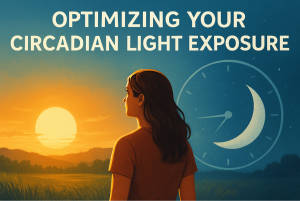Optimizing Your Circadian Light Exposure for Better Sleep and Hormone Balance
5 min read
Circadian light exposure
In today’s fast-paced digital age, more people struggle with poor sleep, chronic fatigue, and hormone imbalances. One often overlooked factor is circadian light exposure—the relationship between natural and artificial light and how it impacts our body’s internal clock.
From the moment sunlight hits our eyes in the morning to the glow of blue light from devices at night, light exposure plays a crucial role in regulating sleep, hormones, metabolism, and mental health. In this blog post, we’ll explore how you can optimize circadian light exposure for better rest, balanced hormones, and improved overall health.
Understanding the Circadian Rhythm
Our circadian rhythm is a 24-hour biological clock that governs sleep, wakefulness, digestion, hormone release, and even mood.
- Controlled by the suprachiasmatic nucleus (SCN) in the brain, it synchronizes with external cues—especially light.
- Morning sunlight signals the brain to produce cortisol (for alertness) and suppress melatonin.
- Evening darkness tells the body to increase melatonin, preparing us for deep sleep.
When this rhythm is disrupted—by irregular sleep schedules, late-night screen time, or minimal daylight exposure—it can cause sleep disorders, fatigue, and hormonal imbalances.
Morning Light: The Key to Resetting Your Internal Clock
Exposure to natural sunlight within the first 30–60 minutes after waking is one of the most powerful ways to regulate your circadian rhythm.
Why Morning Light Matters:
- Boosts Cortisol Awakening Response – A healthy cortisol spike in the morning helps you feel energized and focused.
- Suppresses Residual Melatonin – Exposure to bright natural light signals the brain to stop melatonin production, reducing grogginess.
- Aligns Sleep-Wake Cycle – Regular morning light exposure trains your body to fall asleep earlier and wake up refreshed.
Practical Tips:
- Spend at least 10–15 minutes outdoors after waking (without sunglasses).
- If sunlight is unavailable, use a circadian light lamp or light therapy box.
- Combine exposure with movement—like walking or stretching—for enhanced alertness.
Midday Sunlight: Fuel for Hormonal Balance
While morning light sets the rhythm, midday sunlight reinforces it by providing strong cues to the brain.
Benefits of Midday Light:
- Increases serotonin levels, which later converts to melatonin at night.
- Helps regulate insulin sensitivity, aiding in stable energy and weight control.
- Supports Vitamin D production, essential for immunity, mood, and hormonal health.
Pro Tip: Aim for 20–30 minutes of outdoor exposure around midday. Even sitting near a window is helpful, though direct sunlight is best.
Evening Light: Avoiding Blue Light Disruption
While morning and midday light exposure is beneficial, evening light—especially blue light—can be disruptive.
The Problem with Blue Light:
- Emitted by phones, laptops, TVs, and LED lighting.
- Delays melatonin release, tricking the brain into thinking it’s still daytime.
- Causes difficulty falling asleep, shallow sleep cycles, and nighttime awakenings.
Practical Solutions:
- Digital Curfew – Limit screen use 1–2 hours before bed.
- Blue Light Filters – Use apps like f.lux, Night Shift, or built-in filters on devices.
- Warm Lighting – Switch to amber/red lights in the evening.
- Blue Light Glasses – If screen use is unavoidable, wear glasses that block blue wavelengths.
Darkness: The Forgotten Nutrient for Sleep
Just as exposure to the right type of light is vital, true darkness is equally important for deep, restorative sleep.
Why Darkness Matters:
- Triggers melatonin release, initiating sleep.
- Enhances deep slow-wave sleep, crucial for memory, repair, and recovery.
- Prevents nighttime cortisol spikes that lead to restlessness.
Darkness Optimization Tips:
- Use blackout curtains or an eye mask.
- Remove glowing electronics (phones, chargers, alarm clocks).
- Keep the bedroom cool, quiet, and pitch black for ideal sleep conditions.
Circadian Light Exposure and Hormonal Health
Beyond sleep, circadian light exposure deeply influences hormones such as:
- Melatonin – Regulated by light and darkness; essential for sleep.
- Cortisol – Peaks in the morning with sunlight, declines at night.
- Serotonin – Boosted by daylight; precursor to melatonin.
- Insulin – Better regulated with proper circadian alignment, reducing diabetes risk.
- Reproductive Hormones – Sleep and light exposure impact estrogen, testosterone, and fertility.
When light exposure is optimized, hormone balance improves, leading to better mood, metabolism, and resilience to stress.
Light Exposure, Mental Health, and Mood
Light doesn’t just affect sleep—it plays a huge role in mental health:
- Morning light has been shown to reduce symptoms of depression.
- Proper circadian alignment lowers anxiety and stress levels.
- Seasonal Affective Disorder (SAD) is treated with bright light therapy.
A consistent light schedule acts as a natural antidepressant, helping the brain regulate mood-boosting chemicals.
Science-Backed Strategies to Optimize Circadian Light Exposure
- Morning Sun Ritual – 10–15 minutes outside within an hour of waking.
- Midday Breaks – Step outside for 20–30 minutes during lunch.
- Dim Evenings – Reduce exposure to bright overhead lighting after sunset.
- Tech Hygiene – Use blue light filters and limit screens at night.
- Sleep Cave – Create a completely dark bedroom environment.
- Consistency – Go to bed and wake up at the same time daily.
Tools and Technologies for Circadian Health
- Light Therapy Lamps – Useful during dark winters.
- Smart Bulbs – Adjust light temperature from cool (daytime) to warm (evening).
- Wearable Devices – Track circadian rhythm, sleep cycles, and light exposure.
- Blue Light Blocking Glasses – Protect against artificial light at night.
⚖️ The Modern Dilemma: Balancing Natural and Artificial Light
In modern life, most people spend 90% of their time indoors. Artificial light environments often lack the intensity and spectrum of natural sunlight, leading to circadian misalignment.
Solution: Strive for balance. Seek morning and midday sunlight, minimize evening light pollution, and use tools like light therapy lamps when natural light is scarce.
✅ Key Takeaways
- Circadian light exposure is one of the most powerful factors in regulating sleep and hormones.
- Morning and midday sunlight boost energy, serotonin, and metabolic health.
- Evening blue light disrupts melatonin, delaying sleep and causing hormonal imbalances.
- Darkness is essential for restorative sleep and long-term wellness.
- Simple habits—like morning walks, screen limits, and blackout curtains—can transform your circadian health.
Your circadian rhythm is like a finely tuned orchestra, and light is the conductor. By optimizing circadian light exposure, you can enjoy better sleep, balanced hormones, improved mood, and stronger overall health.
In a world filled with screens, artificial lights, and late-night work schedules, reclaiming your natural light cycle is a powerful, drug-free way to enhance well-being.
Start tomorrow morning—with just 10 minutes of sunlight—and you may notice the difference in your sleep and energy within days.







